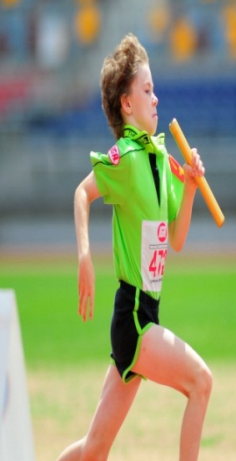All track relay events require four (4) athletes.
What are the different types of relays?
- Shuttle Relay – (standard event for U6 – U8) – 4 athletes line up opposite one another. The first person at one end starts with the baton, runs to the other end and passes it to the first runner there. They continue back and forth etc.
- Circular Relay – 4x100m, 4x200m and 4 x Medley. Each leg of a circular relay is placed around the track. The medley consists of 2 legs of 200m, 1 of 400m and 1 of 800m around the track.
What are the different passing techniques?
- Shuttle Relay – the baton is held vertically at the bottom. It is received at chest level with the receiver’s arms outstretched and their hands creating the shape of a butterfly.
- Circular Relay – Non visual downward pass. This is the safest pass. The receiver has their arm outstretched behind them with their palm facing up and thumb towards the midline of the body. The incoming runner then places the baton downwards into the receiver’s hand.
Where must the baton be passed?
For Circular Relays, there is a “20m change-over zone” in which the baton must be passed. There is also a “10m acceleration zone” for the outgoing runner to build their speed before the change-over zone. There is no acceleration zone for relays or 4 x Medley.
What happens if the baton is dropped during the change?
- If the baton is dropped, the athlete who dropped it must pick it up.
- Athletes may leave their lane to do this as long as they do not interfere with any of the other runners on the track. Once the baton has been retrieved, the athlete can return to their lane and continue with the race. Provided this is done within the change-over zone, there will be no disqualification.
When will a team be disqualified?
- If the baton is thrown between runners.
- If the baton is not carried by hand the whole way.
- If an athlete interferes with any other competitors.
- If the baton is not changed in the “20m change-over zone”
- If athlete runs on or over their inside lane line.






